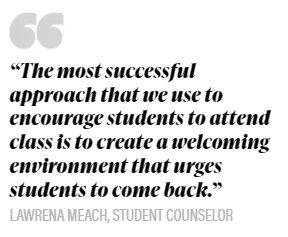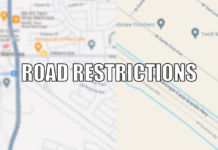 Maricopa Unified School District administrators are taking new steps to combat chronic student absenteeism, which ballooned during the pandemic and is slow to recover in the aftermath.
Maricopa Unified School District administrators are taking new steps to combat chronic student absenteeism, which ballooned during the pandemic and is slow to recover in the aftermath.
Chronic absenteeism, defined by state educators as a student absent from school at least 10% of the time — or 18 days a school year — is worst at MUSD’s middle and high schools, where it hovers around 40%.
“We’re still pretty far from where we were pre-pandemic, so we’ve got work to do,” said Tracey Pastor, MUSD assistant superintendent of administrative services. “But we’re moving in the right direction.”
Pre-pandemic, the high school absenteeism rate was 18%. The middle school rate pre-pandemic was 15% and the elementary schools were at 8%.
A Helios Foundation study shows MUSD’s percentages of chronic absenteeism are similar to Arizona school systems across all grades at 34%. That’s more than double 2019.
Poverty connection
Helios reported chronic absence rates were even higher among economically disadvantaged students, at 42%, and Indigenous students, 48%.
Absenteeism has an outsize effect on families facing poverty, MUSD administrators and counselors say. Something as simple as lack of a family car can cause lengthy student absences.
Then there’s a lack of parental support, something MUSD administrators are addressing through better communications with parents.
“Middle school kids tell the parents, ‘I’m sick, I don’t want to go to school,’” Pastor said. “The parents let it go too easily.”
Student counselors and teachers often come into play, contacting parents to find out why their child’s attendance is low.
Poor attendance can lead to psycho-social effects in students who are missing crucial instruction and social interaction with peers, which can lead to insecurities, said Pima Butte Elementary School counselor Lawrena Meach.
“The most successful approach that we use to encourage students to attend class is to create a welcoming environment that urges students to come back,” Meach said. “Relationships with their peers and staff are a great motivator to come to school.”
She cites Maslow’s Hierarchy of Needs, in which the importance of relationships and a sense of belonging are important to influencing a person’s foundational work to self-actualization and self-fulfillment.
“This means that usually when someone has strong relationships with others and a sense of belonging, they thrive and solidify the confidence within themselves and are encouraged by their own abilities,” Meach said.
Without regular school attendance, a child is left behind, she said.
MUSD administrators and counselors say they believe in contacting parents through letters and emails as an effective way of informing them about the importance of their schoolchildren’s attendance.
 Some educators have resorted to sending the school resource officers, sworn law enforcement agents stationed inside schools, to conduct a welfare check on the student if they are absent for an extended period. That is a last resort.
Some educators have resorted to sending the school resource officers, sworn law enforcement agents stationed inside schools, to conduct a welfare check on the student if they are absent for an extended period. That is a last resort.
Pastor said free and reduced lunch applications are an indicator of family poverty, resulting in a student’s chronic absenteeism.
Pastor shared numbers revealing district schools’ rates of chronic absenteeism through the middle of last year. They show a higher rate of chronic absenteeism in Maricopa’s areas of poverty.
It is highest at Maricopa Wells Middle School, hitting 45% in May 2022 at the height of the pandemic.
Desert Wind Middle School’s rate soared over 43% during the pandemic’s peak.
As of last school year, both middle schools are down to 39% chronic absenteeism.
Both Desert Sunrise and Maricopa High Schools average 39% chronic absenteeism, post-pandemic.
Attendance at the district’s six elementary schools typically trends from 25% to 32% with this lowest chronic attendance at Pima Butte Elementary School — 15%. The highest chronic absenteeism rate among elementary schools was at Saddleback with 32% as of last school year.
The high school problem
The high schools, which report the highest chronic absenteeism, have principals who voiced similar approaches to raising attendance rates: data analysis, attendance and high-absenteeism tracking, personal support for students such as counseling, and family involvement to help address issues causing absenteeism.
Marlene Armstrong, principal at MUSD’s newest high school, Desert Sunrise, said her staff presents a positive school climate and culture, which is essential for encouraging regular attendance.
“Our team works together to create a welcoming environment where students feel valued, safe and connected to their peers and teachers,” she said. “We have begun to implement restorative practices, which foster positive relationships and reduce absenteeism associated with disciplinary issues.”
Staff interventions with chronically absent at-risk students are intended to take place soon, she said.
“Individualized support addresses the unique needs of chronically absent students by assigning mentors or counselors to work closely with at-risk students,” Armstrong said. “They develop attendance plans, set attendance goals and offer incentives that motivate students to improve their attendance habits.”
Deana McNamee, Maricopa High School principal, said addressing chronic absenteeism is a top priority.
“To address this issue, we’ve implemented proactive measures to identify and support chronically absent students while collaborating with staff and parents,” McNamee said.
Both principals describe the typical chronically absent high school student as having poor academic performance, family unrest, mental health issues or transportation needs.
“These challenges often lead to excuses such as health issues, family emergencies or disengagement from school activities,” Armstrong said.
“For instance, some students may be responsible for caring for siblings or performing household chores, while others may face difficulties in accessing reliable transportation to school or struggle to correlate the importance of today’s decisions to future goals and aspirations. Understanding and addressing these challenges are essential in supporting these students and improving attendance rates.”
Armstrong said Desert Sunrise is finding incentive programs are working to increase attendance, such as “Reward Rallies.”
“These fun activities are used as a celebration for everyone who is in attendance on any given day,” Armstrong said. “The students don’t know when or where these activities will happen, but we are creating the fear of missing out on our identified high absenteeism days.”
Teachers play a significant role in encouraging attendance through positive techniques and keeping parents informed, the high school principals said.
McNamee said her high school was implementing new approaches to address chronic absenteeism.
“We are strengthening our communication around students, ensuring that all staff who need to know are aware of unique circumstances so that we can better wrap services around students,” McNamee said. “To support families, we also partner with community organizations, mental health services and social support networks to provide comprehensive support. These initiatives aim to create a supportive environment that encourages regular attendance and student success.”
Incentivizing attendance
Pima Butte Elementary’s rate is markedly lower than the other five elementary schools, and far lower than the district’s middle and high schools.
Pima Butte Principal Elizabeth Allison has had success with an attendance reward system that positively reinforces student attendance. Allison tracks absences and tardies, telling students attendance and punctuality are both important.
The school district is offering rewards to schools for improving their attendance rates, which is chipping away at the chronic absenteeism problem.
It’s a trickle-down effect. For example, the school district gave Pima Butte $250 for good attendance to help support desired initiatives at the school.
“We shifted our focus from perfect attendance prior to COVID to best overall attendance,” Allison said, adding students are recognized and rewarded for regular rather than perfect attendance.
“We highly prioritize regular attendance,” said Allison, who has been Pima Butte’s principal for four years, after two years as assistant principal.
Her students receive trophies and T-shirts as rewards, and classes with 95% attendance are announced to the rest of the school and given high praise for their successes.
“We’re not looking for perfection, we’re looking for progress,” she said.
After seven weeks with 95% attendance, a class will receive a pizza party and a free recess with Allison. The last class with low absences challenged her to a game of four square, she said.
Allison is a believer in teachers and administrators contacting parents and informing them how they can improve their child’s attendance. It has worked in many cases.
Like one fifth grader who went from chronic absentee to insisting on coming to school even when she felt unwell, Allison said. “She doesn’t want to go home because attendance matters to her. That was a real eye-opener.”
Allison and MUSD Communications Director Mishell Terry have shared the success story with other district administrators.




![City gave new manager big low-interest home loan City Manager Ben Bitter speaks during a Chamber of Commerce event at Global Water Resources on April 11, 2024. Bitter discussed the current state of economic development in Maricopa, as well as hinting at lowering property tax rates again. [Monica D. Spencer]](https://www.inmaricopa.com/wp-content/uploads/2024/04/spencer-041124-ben-bitter-chamber-property-taxes-web-218x150.jpg)

![3 things to know about the new city budget Vice Mayor Amber Liermann and Councilmember Eric Goettl review parts of the city's 2024 operational budget with Mayor Nancy Smith on April 24, 2024. [Monica D. Spencer]](https://www.inmaricopa.com/wp-content/uploads/2024/04/spencer-042424-preliminary-budget-meeting-web-218x150.jpg)





![Alleged car thief released without charges Phoenix police stop a stolen vehicle on April 20, 2024. [Facebook]](https://www.inmaricopa.com/wp-content/uploads/2024/04/IMG_5040-218x150.jpg)




![City gave new manager big low-interest home loan City Manager Ben Bitter speaks during a Chamber of Commerce event at Global Water Resources on April 11, 2024. Bitter discussed the current state of economic development in Maricopa, as well as hinting at lowering property tax rates again. [Monica D. Spencer]](https://www.inmaricopa.com/wp-content/uploads/2024/04/spencer-041124-ben-bitter-chamber-property-taxes-web-100x70.jpg)
It’s a cycle. The poorly educated don’t value education. They get lower paying jobs. They have kids and they pass on that same mentality to their kids. Not everyone, but many. 🙁
Congratulations to those who break the cycle.